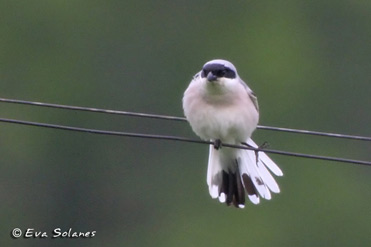The Lesser Grey Shrike Lanius minor could be down to just one pair in Catalonia, in other words it is soon to be extinct in the whole of the Iberian Peninsula. The truth is nobody was betting on the species to hold out much longer. For several years now the known population was reduced to a single site, where despite close monitoring and trapping of Magpies (the main predator of nestlings) the numbers of Lesser Grey Shrikes has gone slowly but steadily downhill. From just over 10 pairs at the turn of the millenium, to 4 pairs in 2008, and now the last one. Will the species have any reason to turn up here next year?
I was embarked on a survey for the Atlas of Breeding Birds of Catalunya 1999-2002 when I chanced upon this as-then unknown breeding population of Lesser Grey Shrikes, on the very edge of the city of Lleida. At the time the discovery seemed to breathe some new life into the hopes for the future of the species in Spain. By then this attractive shrike had disappeared from the Aiguamolls of Empordà in Girona and from the last few pockets remaining to it in Aragón.
In the face of the continued decline of the species it was closely monitored at this site. In fact, the presence of the Lesser Grey Shrike went a long way towards the declaration of the area as a “ZEPA” (SPA), a fact welcomed by a one-in-a-thousand enlightened landowner. Local biologists and conservationists even started working on a reintroduction scheme.

None of this has been enough. Surely, now is the time for all involved to ask themselves if they really thought it was ever going to be enough. If the (public) money spent on the Lesser Grey Shrike, on counting, monitoring, studying and paperwork, had any significance for the conservation of the species? And if anyone so employed believed that getting results was what really mattered the most?
That brings me to an issue which has come to me time and again in my contact with conservation initiatives in this country. Does anybody seriously propound that counting (surveying, censusing) is conservation?
Yes? Then please explain to me how it works, and why the Dupont’s Lark went extinct in Catalonia despite regular censuses, and why the Lesser Grey Shrike is now close to the end of the same path.
No? Then why do so many conservation efforts in Spain (Iberian Peninsula, Catalonia…) focus almost exclusively on solely counting the birds? Where’s the conservation in knowing that a rare species is getting rarer year by year, if you don’t use that information immediately to draw up some plan of remedial action?
That’s my point. Counting is not conservation. It might be many things, most of them good: birding, collaborating, training, group-bonding, identity-forming, whatever. But if no-one has bothered to work out what to do with the results before the count has been done, then it is not going to be of any service at all to the bird in question, ie. it is not conservation.
My proposal is that public funding for counting birds or other beasts should always be conditioned towards action based on the results. In other words, if a species is declining and the cause is known (lack of habitat, disturbance, predation by magpies, etc), then the lion’s share of the available funds should be allocated to action to ameliorate the situation. In other words, action, not numbers.
